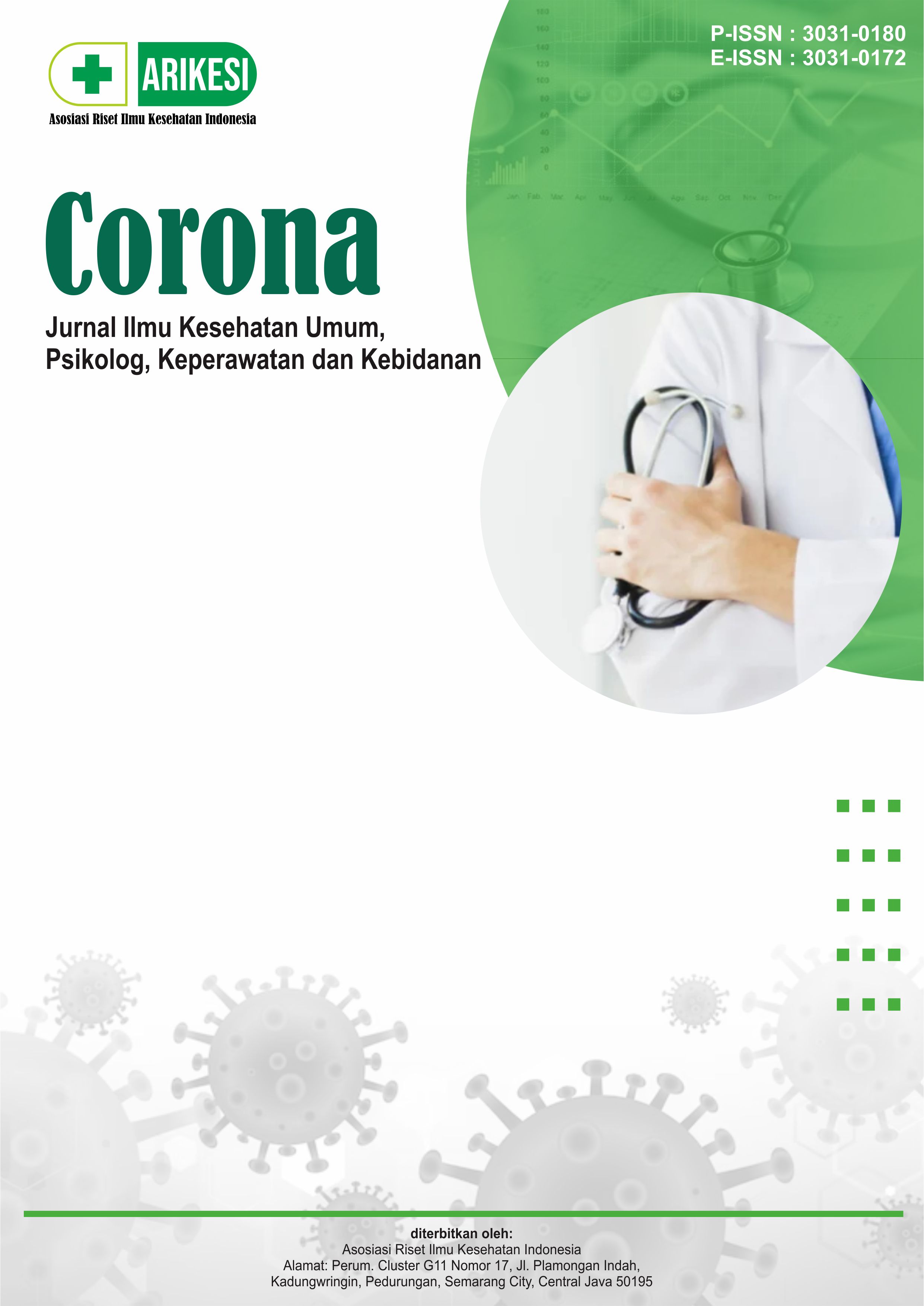Pengembangan Media Poster Pencegahan Obesitas pada Siswa di SMA Negeri 5 Surakarta
DOI:
https://doi.org/10.61132/corona.v2i3.632Keywords:
obesity, poster media, students BibliographyAbstract
Excessive fat accumulation is called obesity. Obesity occurs at all ages, but is most common in the first year of life, at school age and in adolescence. The main behavioral and risk factors for obesity include an unhealthy or unbalanced diet, lack of beneficial activities, such as smoking, and lack of fiber, such as vegetables and fruit. Therefore, preventing and controlling obesity is very important. Nutrition education is an educational approach that functions to increase teenagers' knowledge, attitudes and behavior towards nutritional problems. Education can be done using media, one of which is posters. Posters are a type of media that contain health information with a combination of clear visuals to attract readers' attention. Posters as a health promotion media have the advantage of increasing awareness, trust and attitudes towards health. The aim of this research is to develop poster media for obesity prevention for students at Senior High School 5 Surakarta. This research method uses Research and Development (R&D), with the ADDIE model being developed in 5 stages, namely (Analysis, Design, Development, Implementation, Evaluation). The results of this research showed that the assessment of poster media from stage 1 material experts was 59% inadequate, stage 2 material experts were 62% with decent results, and stage 3 material experts were 76% with decent results. Stage 1 media experts were 88% very decent results, and stage 2 and 3 media experts were 100% very decent. The media aspect got a percentage result of 91%, the media usefulness aspect was 89% which was very feasible. Overall, the average final assessment score was 89.9%, a very decent category. And a field trial was carried out which was attended by 30 students, producing results of 85% from the media aspect and 84% from the media usefulness aspect, including the very feasible category, so it can be concluded that the media developed is "very suitable" for use in preventing obesity in teenagers in Senior High School 5 Surakarta.
Downloads
References
Azhari, M. A., & Fayasari, A. (2020). Pengaruh edukasi gizi dengan media ceramah dan video animasi terhadap pengetahuan sikap dan perilaku sarapan serta konsumsi sayur buah. AcTion: Aceh Nutrition Journal, 5(1), 55-61.
Dhani, S. R., & Yamasari, Y. (2014). Rancang bangun sistem pakar untuk mendiagnosa penyakit degeneratif. Jurnal Manajemen Informatika, 3(2), 17-25.
Ekasari, M. F., & Rosidawati, A. J. (2019). Pengalaman pacaran pada remaja awal. Wahana Inovasi: Jurnal Penelitian dan Pengabdian Masyarakat UISU, 8(1).
Ferinawati, & Mayanti, S. (2018). Pengaruh kebiasaan makan dan aktivitas fisik terhadap kejadian obesitas pada remaja di sekolah menengah Atas Negeri 1 Kecamatan Kota Juang Kabupaten Bireuen. Journal of Healthcare Technology and Medicine, 4(2), 241-257.
Gozali, T. O., & Saraswati, M. R. (2017). Hubungan obesitas pada orangtua dengan terjadinya obesitas pada anak remaja SMA di Kota Denpasar, Provinsi Bali. Jurnal Penyakit Dalam Udayana, 1(1), 22-29.
Kumala, M., & Bardosono, S. (2014). Masalah Gizi Ganda pada Remaja Usia 15-19 Tahun di Lima Wilayah Jakarta. Journal of the Indonesian Medical Association, 64(1), 31-37.
Kurdanti, W., Suryani, I., Syamsiatun, N. H., Siwi, L. P., Adityanti, M. M., Mustikaningsih, D., & Sholihah, K. I. (2015). Faktor-faktor yang mempengaruhi kejadian obesitas pada remaja. Jurnal Gizi Klinik Indonesia, 11(4), 179-190.
Marisa, M., & Nuryanto, N. (2014). Pengaruh pendidikan gizi melalui komik gizi seimbang terhadap pengetahuan dan sikap pada siswa SDN Bendungan di Semarang (Doctoral dissertation, Diponegoro University).
Notoatmodjo, S., et al. (2012). Promosi kesehatan di sekolah. Jakarta: Rineka Cipta.
Nurhayati, T. (2016). Perkembangan perilaku psikososial pada masa pubertas. Edueksos Jurnal Pendidikan Sosial & Ekonomi, 4(1).
Putri, R. N., Nugraheni, S. A., & Pradigdo, S. F. (2022). Faktor-Faktor yang Berhubungan dengan Kejadian Obesitas Sentral pada Remaja Usia 15-18 Tahun di Provinsi DKI Jakarta (Analisis Riskesdas 2018). Media Kesehatan Masyarakat Indonesia, 21(3), 169-177.
Ratiyah, R. (2023). Pengaruh edukasi dengan booklet tentang kekerasan seksual terhadap tingkat pengetahuan remaja putri di MAN 2 Ketapang (Doctoral dissertation, Universitas Kusuma Husada Surakarta).
Siagian, A., Jumirah, J., & Tampubolon, F. (2010). Media Visual Poster dan Leaflet Makanan Sehat serta Perilaku Konsumsi Makanan Jajanan Siswa Sekolah Lanjutan Atas, di Kabupaten Mandailing Natal. Kesmas: Jurnal Kesehatan Masyarakat Nasional (National Public Health Journal), 4(6), 262-268.
Sugiyono, D. (2013). Metode penelitian pendidikan pendekatan kuantitatif, kualitatif dan R&D.
Sumiyati, S., & Irianti, D. (2021). Obesitas terhadap harga diri remaja. Jurnal Sains Kebidanan, 3(2), 80-85.
Tafonao, T. (2018). Peranan media pembelajaran dalam meningkatkan minat belajar mahasiswa. Jurnal Komunikasi Pendidikan, 2(2), 103-114.
Wallengren Lynch, M. (2018). Using conferences poster presentations as a tool for student learning and development. Innovations in Education and Teaching International, 55(6), 633-639.
Yusandika, A. D., Istihana, I., & Susilawati, E. (2018). Pengembangan media poster sebagai suplemen pembelajaran fisika materi tata surya. Indonesian Journal of Science and Mathematics Education, 1(3), 187-196.
Downloads
Published
How to Cite
Issue
Section
License
Copyright (c) 2024 Corona: Jurnal Ilmu Kesehatan Umum, Psikolog, Keperawatan dan Kebidanan

This work is licensed under a Creative Commons Attribution-ShareAlike 4.0 International License.





